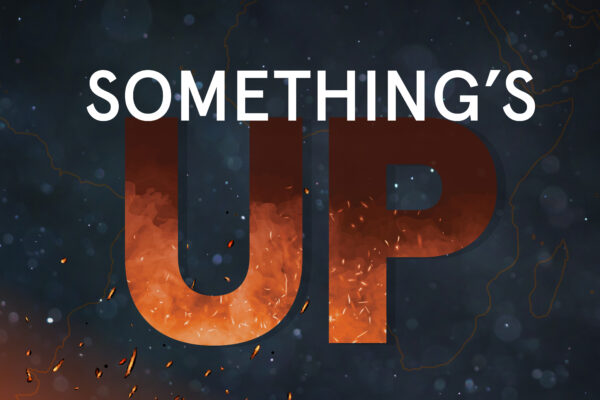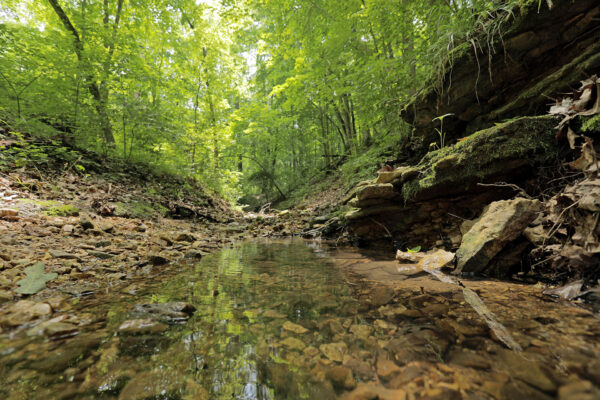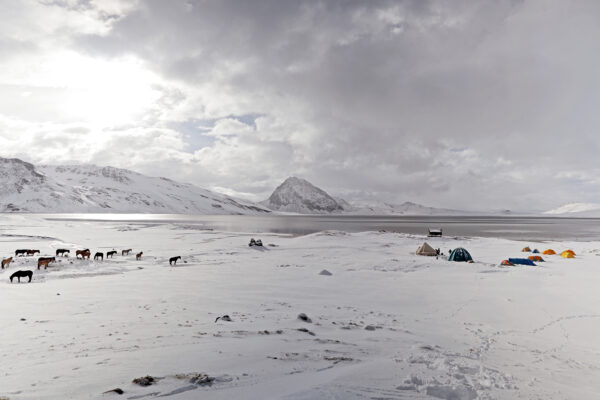Frequently flooded and accessible only by dinghy, Ellis Island in the Mississippi River near Alton, Illinois, seems like an unlikely place to launch one part of a clean energy revolution.
But that’s exactly what Arpita Bose, associate professor of biology in Arts & Sciences, aims to do with the help of microbes harvested from this wetlands area, which is part of the Riverlands Migratory Bird Sanctuary. She believes these organisms have an important role to play in fighting climate change.
“Here in this area (between Missouri and Illinois), we’re surrounded by water,” Bose says. “It’s a unique ecosystem because some of these wetlands get flooded periodically. Flooding affects microbial diversity, and it affects carbon sequestration — it affects everything.”
Inspired by the wild microbes she discovered as a Life Sciences Research Foundation Fellow (supported by the Howard Hughes Medical Institute) at Harvard University, Bose is looking for similarly beneficial organisms in local waterways.
In the past, she found these microbes in the muck of an estuary at Woods Hole, Massachusetts — a place where fresh water from a river mixes with the salty ocean. Some microbes that live in this estuary are adapted to survive and grow where there is no oxygen. But other microbes that live in inland wetlands have to deal with flooding, which brings the same sorts of harsh, anaerobic conditions that their coastal cousins face. That’s why Bose thinks she might be able to find something special nearby.
“Most people think of microorganisms as nasty microbes that cause disease, but I’m more of a glass half full sort of person,” Bose says. “Microorganisms are everywhere, doing really positive things for us, too.”
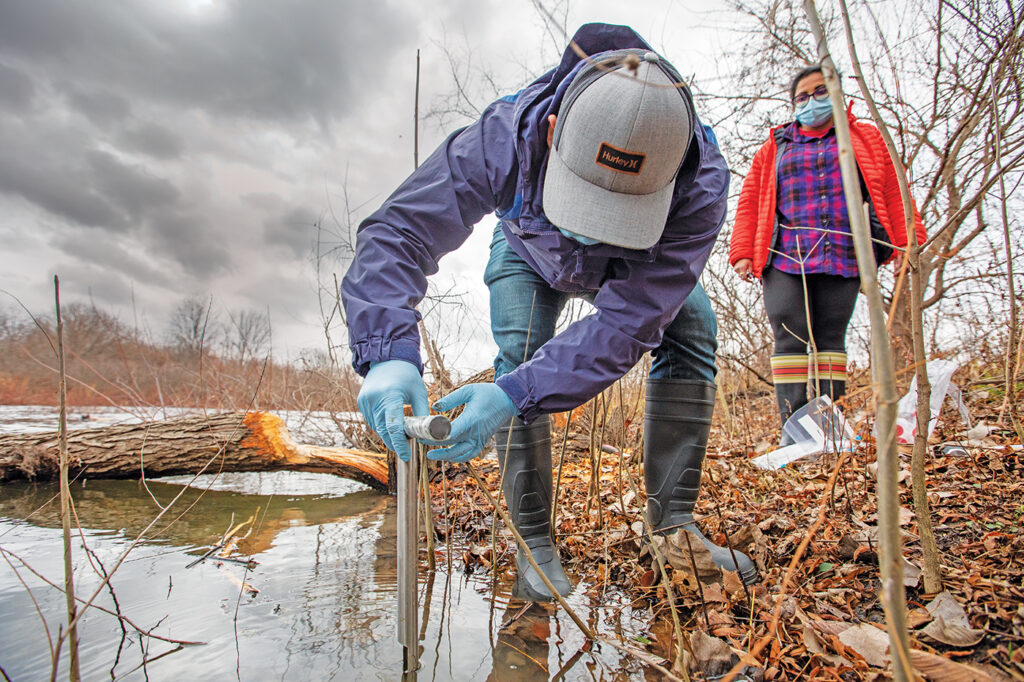
A living system
Back in her Washington University research space in Busch Lab on the Danforth Campus, Bose keeps batches of different microbes cooled to -79 degrees Celsius in a deep freezer.
They don’t seem to mind. This form of life has persisted on Earth across millennia and through all kinds of dramatic shifts in climate and surface conditions. From the microbes’ perspective, they’re just waiting out this (artificially induced) ice age before they can breathe, eat and reproduce again.
In fact, it’s what they eat — and how they eat it — that fascinates Bose.
“Microorganisms have evolved a bewildering array of techniques to obtain nutrients from their surrounding environments,” she says.
Bose studies microbial metabolisms, and she is particularly interested in microorganisms that can “eat” electricity in its many forms.
One of the microbes in her menagerie, called Rhodopseudomonas palustris TIE-1, is a purple bacterium with unusual metabolic flexibility, including the ability to pull electrons out of iron or directly from an electrode.
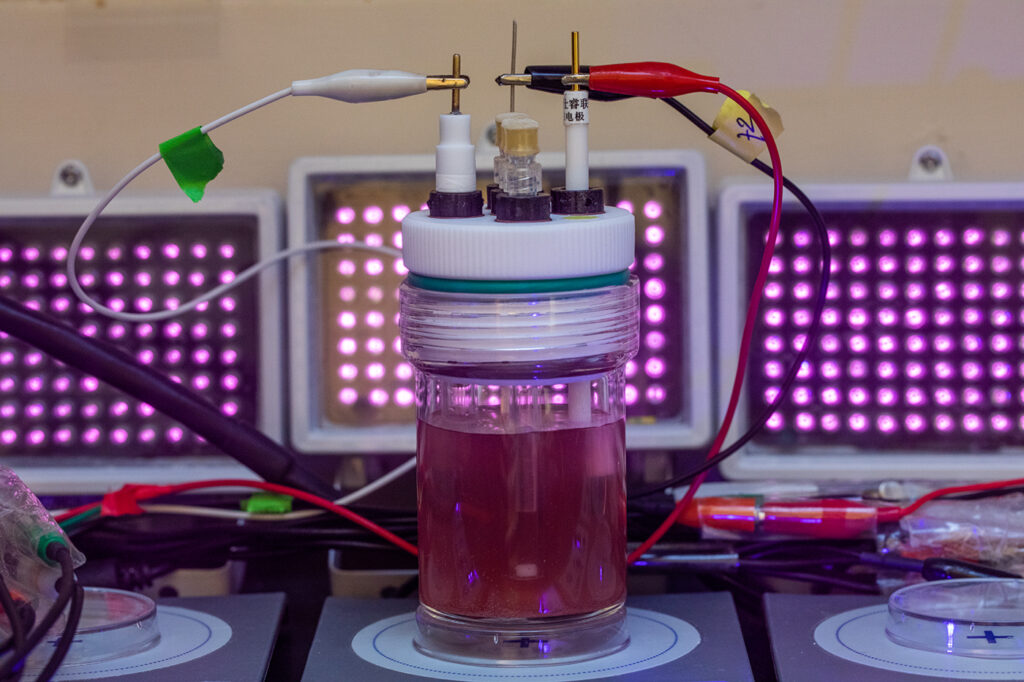
Last year Bose made a splash by publishing a study that revealed a new way to train this microbe to make a biofuel called n-butanol. This fuel alternative is authentically carbon-neutral and can be readily used in blends with diesel or gasoline. The best part about it, according to Bose, is that microbes can make this fuel using only three renewable and naturally abundant source ingredients: carbon dioxide (CO2), solar panel-generated electricity and light.
Bose has also previously coaxed these microbes into making bioplastics, as a way of grappling with what she calls “rampant petroleum-based plastic use and plastic waste.”
As scientists learn more about these microbes, their potential uses are more and more promising, Bose says, though she acknowledges that improvements are needed before her techniques can be rolled out on larger scales.
“The research is new. Therefore, the biggest challenge for scaling up is that we don’t know how to do it fundamentally,” says Haluk Beyenal, a professor of chemical engineering and bioengineering at Washington State University, who is helping Bose to think about how to expand her biofuels production effort. “Scale-up strategies for chemical engineering systems are well-defined, and we know which parameters should be used. However, we currently don’t know which parameters are critical for scale up for bioelectrochemical systems.
“Arpita’s work starts there: from the fundamentals,” Beyenal continues. “This is critical for developing laboratory, then pilot and, ultimately, industrial-scale technologies. In the long term, her work on wiring microbes to electrodes to produce biofuels and bioplastics will enable us to develop transformational technologies.”
Part of a clean energy revolution
First-generation biofuels were rolled out with the best intentions: to replace the use of liquid fossil fuels, especially for transportation uses.
These kinds of biofuels are produced from biomass such as corn, soy and sugarcane. The biofuel is made through fermentation or chemical processes that convert the oils, sugars and starches in the biomass into liquid fuels.
But first-generation biofuels in general — and corn-generated ethanol in particular — face three major criticisms. First, some say that the source material should be used for food, not fuel. Second, biofuel production from corn or other biomass often requires significant consumption of fossil resources, such that there are minimal benefits from a carbon-emissions perspective. Finally, there’s a requirement of land to grow corn.
Second- and third-generation biofuels are now being developed that overcome these criticisms. Bose’s microbes are an important part of this mix.
“The way that we grow these organisms connects the dots between renewably produced electricity and the consumption of CO2 or other problematic carbon sources or greenhouse gases. We’re converting them into something usable.”
— Arpita Bose
The fuel she is making, n-butanol, has a high energy content and low tendency to vaporize or dissolve in water without combustion, making it a good replacement for ethanol. Her cost analyses show that her microbes are capable of making biofuels at a level that is potentially “commercializable,” with some help from engineers in scaling it up.
Climate change ‘solutionaries’
The alarm clock rings early for global scientists. Like 3:30 a.m. early, every day of the week.
Bose pushes her long, black hair back into a ponytail and sits down at her computer in the dark, hours before her 6-year-old daughter wakes. This year Bose is participating in an intensive training program called the Anant Fellowship for Climate Action. Every morning she signs on to join an elite group of 30 scientists and leaders — the program dubs them climate change ‘solutionaries’ — discussing potential actions to mitigate climate change.
Austria. Nigeria. India. Barbados. The fellows hail from countries around the world (hence their compromise on what time to gather each day on Zoom).
Bose was selected to participate based on the strength of her research with microbes and sustainability — including her work on both carbon sequestration and sustainable bioproduction. A 2015 Packard Fellow, Bose earned a PhD in microbiology from the University of Illinois at Urbana-Champaign. She also has an MS in biotechnology from the All India Institute of Medical Sciences in New Delhi, India, and earned a BS in microbiology from the University of Delhi.
“I think climate change has really captured the collective imagination during the COVID pandemic. People have been home, and they’ve been more connected to nature than ever before. For some, it’s been their only outlet. For a period of time, all we could do was go for walks and look around and enjoy nature.”
— Arpita Bose
“Suddenly, there’s this recognition that the environment is something that we have to preserve,” she says. “It’s for posterity; it’s for our children.” It is a sentiment that she has been working hard to communicate, starting with members of her own family.
“I’ve been trying to tell my daughter (without creating climate anxiety): ‘You are part of this process, but you are part of the solution as well,’” Bose says. “Because they’re so young, children might hold the key to solving this problem of climate change as a human race.
“We’ve solved such difficult problems in the past. Why couldn’t we solve this?” Bose asks. “We have to engage people in a positive way.”
Collaboration and inclusion
From the time that she was hired at Washington University in 2014–15, Bose has reached out across the university, finding collaborative solutions in surprising places.
“I knew that to do climate science, which is what I’m especially interested in, and do it well, I’d need collaborators from across disciplines,” Bose says. “As a microbiologist, I study microbes in the lab. Sometimes I go out and collect samples in the field to study. But, at the end of the day, I have to depend on the expertise of scientists across fields, from earth and planetary sciences to engineering.”
One of her newer collaborations is with Mark Meacham, assistant professor of mechanical engineering & materials science in the McKelvey School of Engineering. Together they were awarded the university’s first Defense Established Program to Stimulate Competitive Research award from the U.S. Department of Defense since 1996. They are combining their expertise to understand extracellular electron uptake in bacteria — a key part of the process that allows microbes to convert CO2 into something useful.
Bose was recently selected for a Climatebase Fellowship, a program designed for entrepreneurs in climate technology, and she’ll serve as an Island Innovation Ambassador, where she will help leaders of small island nations address climate-related challenges. She is also highly involved in mentoring local high school students, including welcoming interns from Gateway Science Academy of St. Louis, and building a more diverse and inclusive STEM pipeline. As associate editor of the journal Applied and Environmental Microbiology, she hopes to improve trans-parency, diversity, inclusivity and fairness in peer-reviewed scientific publishing, especially for early-career scientists.
In recognition of these and other outreach efforts, Bose was selected to serve as a faculty marshal in the university’s graduate student ceremony in May 2021.
“Professor Bose is such an inspiration,” said ceremony organizer Laurie Maffly-Kipp, the Archer Alexander Distinguished Professor, who was then working as the interim vice provost of graduate education. “Her dedication to mentoring students at all levels, and to finding pipelines to attract women and students of color into STEM fields, is a model for what we should be doing here at WashU.”
Bose said she was honored to participate.
“As faculty, our efforts to diversify the STEM fabric can often be overlooked compared to our research efforts,” Bose says. “I believe that I have a key role as an educator and scientist to help create opportunities for all students. To me, my research efforts are intertwined with my efforts to diversify STEM. One is not without the other.”
Back to the wetlands
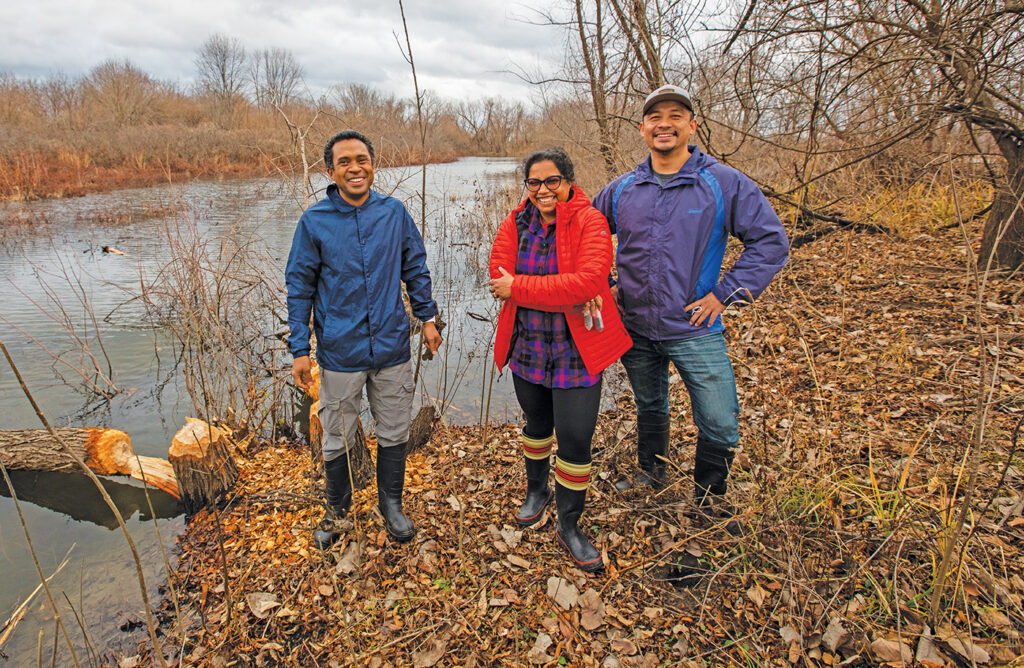
The latest report from the Intergovernmental Panel on Climate Change is frank: Climate change is “widespread, rapid and intensifying,” and mitigating global warming will require humans to limit their cumulative CO2 emissions and reduce other greenhouse gases. Plastic waste represents a related and daunting worldwide problem. Global plastic production now averages more than 300 million metric tons per year, which is a staggering increase over the 1.5 million metric tons produced in 1950.
Innovations like those that Bose is pursuing can help address these challenges. Her basic science research has the potential to lead to engineered solutions with a real, positive impact for the global environment.
Back at Ellis Island, Bose and members of her team are currently focused on learning more about the carbon sequestration potential of the freshwater microbes (freshwater phototrophic bacteria — the ones that can do photosynthesis) they are finding along the shoreline. They hope that their research can also help to lay the groundwork for additional protections for these threatened ecosystems.
“Ellis Island is one of the inland freshwater wetland ecosystems in Missouri that was not described as part of the most recent National Wetland Condition Assessment,” says Rajesh Singh, a research scientist in the Bose lab. “This study will help provide scientists with a data set that is representative of the Mississippi River’s freshwater inland wetland area for exploring the role of microbes in carbon cycling, particularly anoxygenic phototrophs.”
Despite occupying only 5%-8% of Earth’s land surface, wetlands soils hold up to 30% of the carbon that is locked away in the ground. Bose and scientists on her team want to know more about the microbial processes that are keeping that carbon at bay.
“There’s a disconnect where we do not appreciate the value of freshwater wetlands,” Bose says. “But wetlands have a massive role ecologically.
“Freshwater wetlands, we know, hold a lot more carbon than marine wetlands,” Bose says. “But we don’t fully understand the basis of this difference.”
Further research is needed to determine the factors that control how much carbon is sequestered by plants and microbes in wetlands. With this knowledge, Bose says, humans could take better advantage of wetlands that are already being set aside for preservation and protection.
“We have these existential issues, climate change being one of them,” Bose says. “I know that we can find microbial solutions. They won’t be the only ones, of course. But I’ve realized we need an all-hands-on-deck approach right now.”
